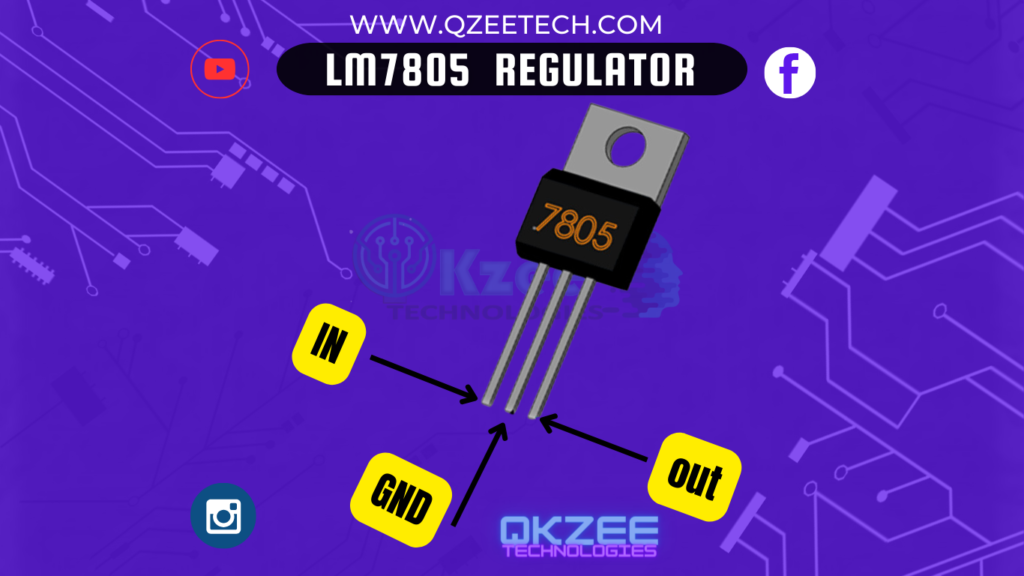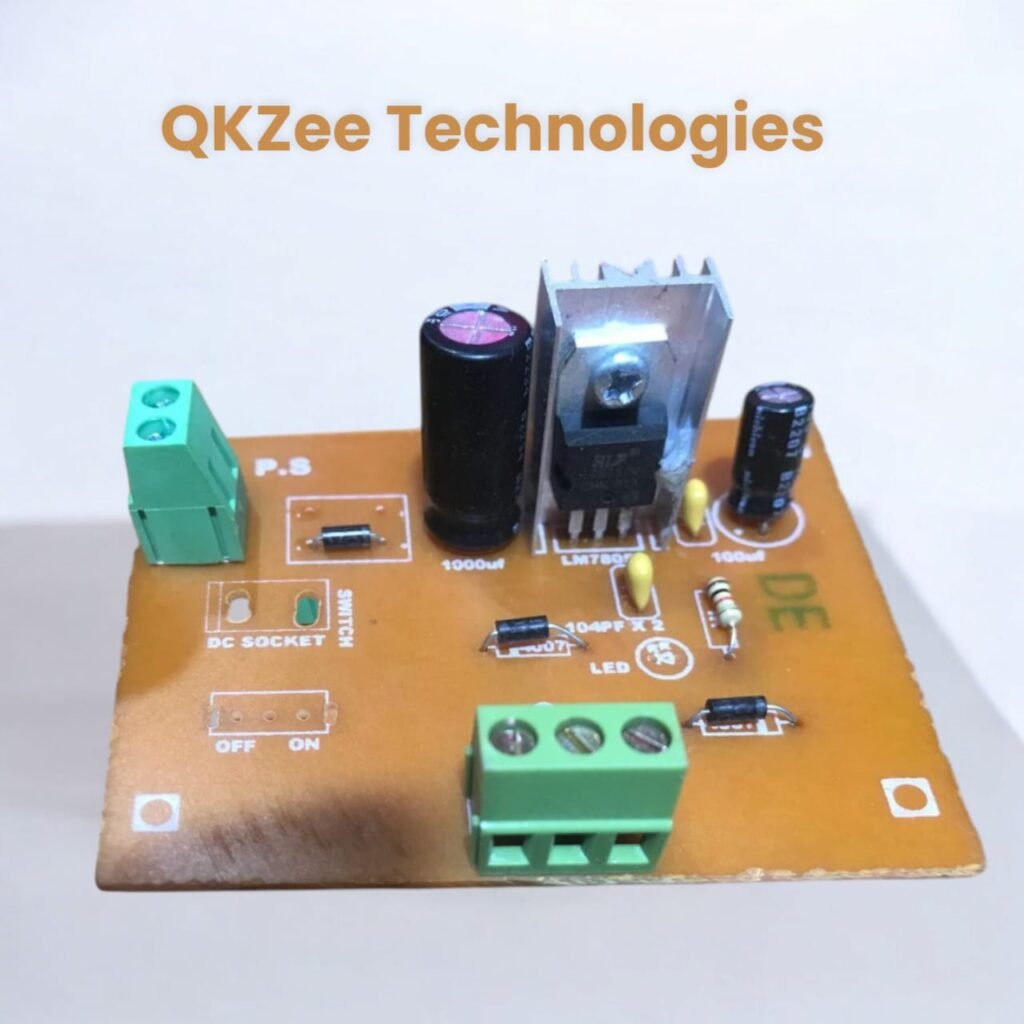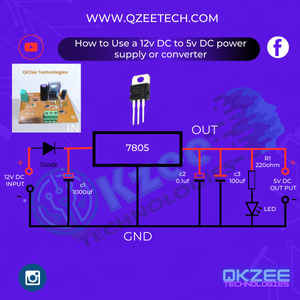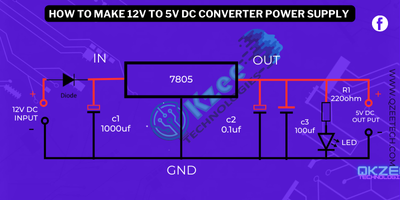How to Make a 12V DC to 5V DC Converter Power Supply Using 7805: A Complete Guide

How to Make a 12V DC to 5V DC Converter Power Supply Using 7805: A Complete Guide
Introduction to 12V to 5V DC Converters
If you’re working on student projects, final year projects (FYP), or DIY electronics, you’ll often need a reliable 5V power supply. Many devices like Arduino boards, sensors, and microcontrollers require 5V DC. However, most batteries or adapters provide 12V DC. This guide will show you how to build a simple, cost-effective 12V to 5V DC converter using the 7805 voltage regulator. Perfect for engineering projects, science projects, and automation tasks, this project is ideal for students, hobbyists, and professionals across all universities in Pakistan and technical colleges.
Why Use the 7805 Voltage Regulator?
The 7805 is a linear voltage regulator IC that converts higher DC voltages (7V to 35V) to a stable 5V output. It’s affordable, easy to use, and widely available at electronics stores like Hall Road Lahore. Whether you’re building Arduino projects or prototyping circuits for school projects, the 7805 is a go-to component for beginners and experts alike.
Components Required
-
-
7805 Voltage Regulator IC
-
The core component of this project. It regulates the input voltage (12V) to a steady 5V output.

-
-
Capacitors (1000µF, 0.1µF and 100µF)
-
Used to filter noise and stabilize voltage. A 1000µF capacitor is placed at the input, and a 0.1µF and 100µF capacitor at the output.
-
-
diode 4007
-
Diode 4007 for forward biasing in the input.

-
-
Heat Sink
-
The 7805 generates heat when converting higher voltages. A heat sink prevents overheating and ensures longevity.
-
-
Resistors (Optional)
-
This is for current-limiting or LED indicators (if needed).

-
-
PCB or Breadboard
-
For assembling the circuit. Breadboards are ideal for prototyping, while PCBs are better for permanent setups.
-
-
12V Power Source
-
A 12V battery, adapter, or power supply.
-
-
Connecting Wires
-
To link components on the breadboard or PCB.
Where to Buy Components?
Components are available at Qkzee Technologies Hall Road Lahore, an electronics hub. For online purchases, check Qkzee Tech or Qkz Tech, which cater to engineering services and DIY enthusiasts.
Step-by-Step Guide to Building the Converter
Step 1: Understand the 7805 Pin Configuration
The 7805 has three pins:
-
- Input (Pin 1): Connects to the 12V source.
- Ground (Pin 2): Connected to the common ground.
- Output (Pin 3): Delivers the regulated 5V.
Step 2: Circuit Design
Here’s a basic schematic:
-
- Connect the 12V input to Pin 1 of the 7805 and Diode 4007 pin 1 as forward-biased.
- Attach a 1000µF capacitor between Pin 1 and ground to reduce input noise.
- Connect Pin 2 to ground.
- Attach a 0.1µF and 100µF capacitor between Pin 3 (output) and ground for output stability.
- Add an LED with a resistor (e.g., 220Ω) to the output as a power indicator (optional).

Step 3: Assemble on Breadboard or PCB
For prototyping, use a breadboard. For permanent setups, design a PCB using software like Eagle or KiCad. Qkzee Technologies offers PCB design services for FYP projects in Lahore.
Step 4: Add a Heat Sink
Solder a heat sink to the 7805 to dissipate heat. Without it, the IC may overheat and fail.
Step 5: Test the Circuit
Use a multimeter to check the output voltage. If it reads 5V ± 0.25V, the circuit works!
Common Issues and Troubleshooting
-
-
Overheating
-
If the 7805 gets too hot, ensure the input voltage isn’t too high (ideally 7V–12V). Use a larger heat sink or a switching regulator for high-current applications.
-
-
Voltage Drops
-
If the output is below 5V, check for loose connections or faulty capacitors.
-
-
Noise in Output
-
Add a 100µF electrolytic capacitor at the output for better filtering.
Applications of the 12V to 5V Converter
-
-
Arduino and Raspberry Pi Projects
-
Power Arduino Uno, ESP8266, or sensors in IoT and automation projects.
-
-
DIY Electronics
-
Build portable chargers, LED drivers, or small robots.
-
-
Academic Projects
-
Ideal for school projects, science projects, and engineering service prototypes at all technical colleges in Pakistan.
Why This Project is Perfect for Students
This converter is a fundamental project for electrical engineering students. It teaches voltage regulation, circuit design, and troubleshooting. Plus, it’s a great addition to portfolios for final year projects or internships with the best engineering services in Lahore.
Where to Get Professional Help?
For complex FYP projects in Lahore, reach out to Qasim Shahzad Lahore or Qkzee Technologies. They offer expert engineering services and mentorship.
Conclusion
Building a 12V to 5V converter using the 7805 is a simple yet valuable skill for students, hobbyists, and engineers. With components from Hall Road Lahore or online stores like Qkz Tech, you can create a reliable power supply for Arduino projects, school experiments, or industrial prototypes. Whether you’re searching for “engineering services near me” or tackling DIY electronics, this guide equips you with the knowledge to succeed!
Where to Buy Your Electronics Components
Looking for affordable components for this Arduino project? Check out QKZee Technologies, an online shop in Lahore, Pakistan, offering the best components for students and DIY projects. Whether you’re looking for sensors, modules, or other electronics at a cheap price, they’ve got it all. Visit them at QKZeeTech.
Can I use the 7805 to power my Arduino directly?
Yes, absolutely! The 7805 provides a stable 5V output, which is ideal for Arduino boards like Uno, Nano, or Mega. Just make sure your input voltage is between 7V to 20V, and always add capacitors for smoother voltage.
Why is my 7805 getting hot?
The 7805 dissipates excess voltage as heat. If you’re converting from 12V to 5V and drawing high current, it will heat up quickly. Use a heat sink or cooling fan if needed.
Do I need capacitors with the 7805?
Yes. A 100µF capacitor at the input and a 0.1µF at the output are recommended for stable performance. You can also use 10µF or higher electrolytic capacitors to filter voltage more effectively.
Can I use this converter in my final year project or science project?
Definitely! This 12V to 5V converter is perfect for student projects, final year projects, DIY systems, Arduino automation, and school science projects. It's widely used in universities and technical colleges across Pakistan.
Where can I find the 7805 and other components in Pakistan?
visit QKZee Technologies Hall Road Lahore, or contact QKZee Technologies for genuine parts and student-friendly prices



